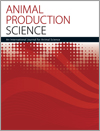
Animal Production Science
Volume 63 Number 15 2023
AN22315A regional-scale assessment of nutritional-system strategies for abatement of enteric methane from grazing livestock
In Australia, 73% of the greenhouse gas emissions from the agriculture sector come from methane from sheep and cattle. Simulations using New South Wales data summarised opportunities in achieving methane suppression to inform policy recommendations, and guide investment and management decisions. This assessment showed pathways involving changes in farm-management practices applied to grazing animals as well as more intensive systems (feedlot and dairy) to lower methane emissions.
AN22315 Abstract | AN22315 Full Text | AN22315PDF (1.5 MB) Open Access Article
Providing feed is the largest cost in beef production. Genetic variation exists in feed efficiency measured in young cattle, but the genetic association with feed efficiency in cows is poorly understood. The genetic correlation between feed efficiency measured in young cattle with that measured in cows was found to be very high, meaning that inclusion of feed efficiency measured on young animals in beef cattle breeding can be expected to lead to improvement in cow feed efficiency.
AN23070Evaluation of a dietary blend of essential oils and polyphenols on methane emission by ewes
The use of bioactive compounds as rumen modifiers is a promising strategy for decreasing the emission of enteric methane from ruminants. This study examined the effect of feeding ewes with a dietary blend of essential oils and polyphenols on methane emission, which was measured in vivo using ventilated hoods. The tested blend led to significantly decreased (−13%) emission of methane per unit of ingested dry matter, suggesting this technique may be effective at the level of individual farms.
AN22300Effects of dietary Sanguisorba minor, Plantago lanceolata, and Lotus corniculatus on urinary N excretion of dairy cows
 , S. L. Amelchanka
, S. L. Amelchanka  , C. Baki, C. Kunz, A. K. Steiner, M. Kreuzer and F. Leiber
, C. Baki, C. Kunz, A. K. Steiner, M. Kreuzer and F. Leiber 
A major environmental problem caused by dairy production systems are losses of urinary nitrogen, which may affect climate and environment through the pathways of ammonia, nitrous oxide or nitrate. Tannins, binding easily degradable protein in the rumen, may be advantageous in this respect when included in diets for ruminants. The current study identified small burnet as a tannin-rich fodder herb with potential to mitigate urinary nitrogen excretion of dairy cows.
AN22300 Abstract | AN22300 Full Text | AN22300PDF (434 KB) Open Access Article
The synthesis of organic Se, such as Se-yeast (SeY), in large-scale production may be limited by the high costs, being time consuming, and their containing only trace concentrations of Se, which may limit their application. The current research compared the effects of dietary supplementation of two new forms of organic Se, Se–chitosan (SeCh) and selenised glucose (SeGlu), both with a wide range of physiological activities, as well as the interaction of these compounds with probiotics, on broiler chicken growth, carcass characteristics, meat quality, and meat Se concentration.
AN22294Effect of coated sodium butyrate in diet on performance, gut microbiota, ileal digestibility, serum nutrient fractions, immune responses and bone mineral variables in broiler chicken fed antibiotic-free diet
 , V. L. N. Raju Mantena, Shyam Sunder Paul, Nagalakshmi Devanaboyina, Srilatha Thota, Prakash Bhukya and Santosh Phani Kumar Prakki
, V. L. N. Raju Mantena, Shyam Sunder Paul, Nagalakshmi Devanaboyina, Srilatha Thota, Prakash Bhukya and Santosh Phani Kumar Prakki
Alternatives for feed antibiotics (AGP) are essential in broiler diets for the interest of human population. The current findings indicated that coated sodium butyrate (75 or 150 g/t) can be used as an alternative to the AGP in broiler diet, maintaining growth and reducing the pathogenic bacteria count (E. coli and C. perfringes) in chicken intestine. Utilising these findings, we can produce broiler meat without antibiotic residue and without causing microbial resistance to antibiotics.
AN23052Post-weaning performance of Nellore calves subject to different weaning methods
 , Kaliandra Souza Alves, Luis Rennan Sampaio de Oliveira and Daiany Iris Gomes
, Kaliandra Souza Alves, Luis Rennan Sampaio de Oliveira and Daiany Iris Gomes 
The stress on calves caused by abrupt maternal separation can cause behavioural, physiological, and physical changes, negatively impacting the growth rate and delaying the animal’s slaughter age. In this way, alternative weaning methods may minimise the negative impacts on male and female calves during the post-weaning phase. Thus, the use of trainers or facilitators cows during the weaning of Nellore calves contribute to higher animal performance during the post-weaning phase.
Cassava root processing for human consumption often produces by-products, such as cassava root sievate, that are conventionally wasted but contain significant level of energy and lignin. These can be better utilised as goat feed following biological treatment. Biological treatment of agricultural by-products is effective in lignin degradation and improving the nutritive value of low quality feedstuffs. Our research demonstrated that feeding goats with biologically treated cassava root sievate promoted feed intake, body weight gain, digestibility and nitrogen balance.
AN22413Estimating potential farm economic benefits of advanced microbiological diagnostics in veterinary medicine
Polymerase chain reaction (qPCR) diagnostic methods can improve the precision and speed of veterinary diagnostics. This paper develops an analytical framework to quantify the farm economic benefits of decentral qPCR. For calf pneumonia, we estimate the potential economic gain to be 7.8% of the gross margin, and for weaner pig diarrhoea, the potential economic gain is an estimated 3.1% of the gross margin.



